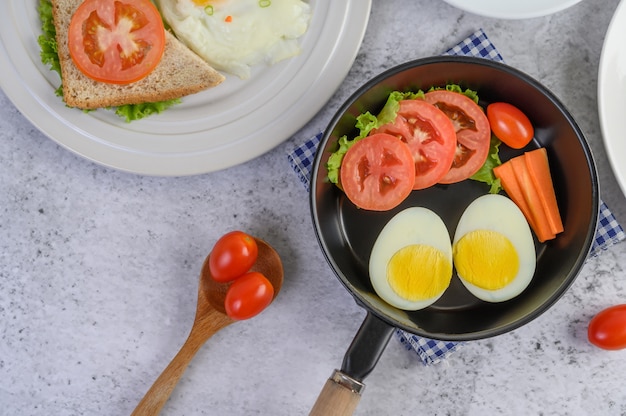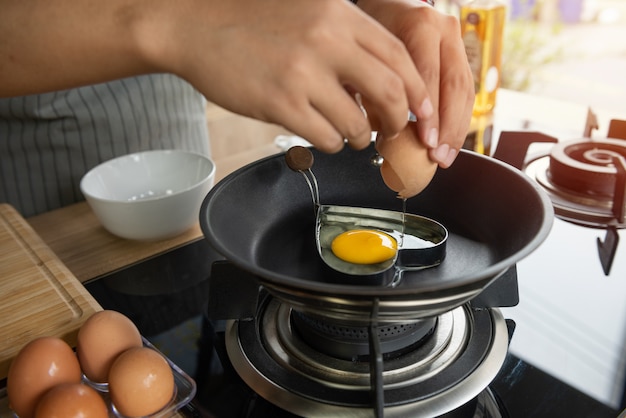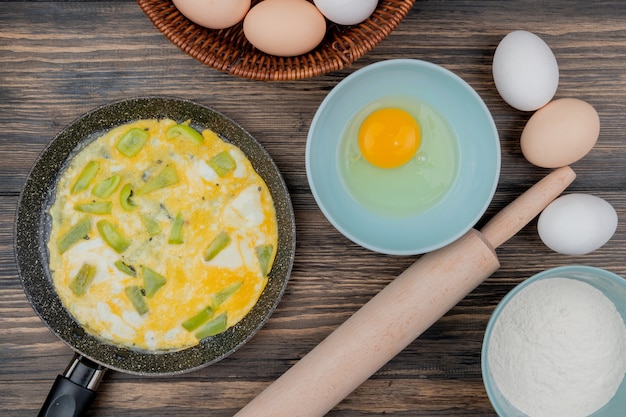Let's talk about those glorious, golden-yolked beauties that are the heart of a satisfying breakfast – over-easy eggs. They're a classic for a reason, you know? Simple, satisfying, and, when done right, utterly heavenly. Now, I'll admit, I wasn't always a master of the over-easy egg. There was a time when my attempts would end up looking more like scrambled messes than the perfectly runny, golden discs I longed for. But with a bit of practice and some helpful tips, I cracked the code (pun absolutely intended!).
So, if you're a bit intimidated by the idea of cooking the perfect over-easy egg, don't worry. I'm here to guide you through every step of the process. We'll cover everything from choosing the right pan to flipping those eggs like a pro. By the end of this guide, you'll be whipping up over-easy eggs like a seasoned chef.
(Part 1) The Essentials for Over-Easy Egg Perfection

Choosing the Right Pan: The Foundation for a Great Egg
First things first, you need the right pan. I've tried a whole lot of pans over the years, and here's what I've learned:
cast iron pan: The King of Even Heat: This is my go-to for over-easy eggs. The cast iron's even heat distribution ensures the whites cook evenly without burning the yolks, and it adds a lovely crispy edge to the eggs. The only downside? You'll need to season it regularly with oil to prevent rust, but that's part of its charm.
non-stick pan: A Great Alternative: If you're not a fan of cast iron, a good quality non-stick pan is a great alternative. Just be sure it's well-seasoned and doesn't have any scratches. Otherwise, your eggs might stick, and nobody wants that.
The Perfect Egg: Freshness Matters
Don't underestimate the importance of fresh eggs. They make all the difference in the world! Here's how to tell if your eggs are still good:
- The "Float" Test: Place an egg in a bowl of cold water. If it sinks to the bottom and lies flat, it's fresh. If it stands on its end, it's getting a bit older. If it floats, it's definitely time to toss it. The air pocket inside the egg gets bigger as it ages, making it less dense.
- The "Smell" Test: If an egg has a bad smell, it's gone bad. No ifs, ands, or buts. Don't even bother with it. A rotten egg will have a pungent, sulfurous odor.
(Part 2) The Art of cooking over-easy eggs

Preparing the Pan: It's All About Heat
Now, the fun part: cooking!
1. Heat the Pan: Heat your chosen pan over medium heat. You want it hot enough to cook the eggs quickly but not so hot that the whites burn. The perfect temperature is when a drop of water sizzles immediately upon contact.
2. Adding Fat: Once the pan is hot, add a tablespoon or two of butter or oil. The fat helps prevent the eggs from sticking to the pan and adds a lovely richness to the eggs. I personally prefer unsalted butter for the best flavor.
Cracking and Cooking the Eggs: Timing is Key
1. Crack the Eggs: Carefully crack the eggs into a bowl. This way, you can make sure there's no shell in your eggs. A small crack in the egg can be easily fixed with your fingers, but if it's a big crack, use a fresh egg.
2. Slide 'em In: Gently slide the eggs into the hot pan. The butter or oil should sizzle a bit. You'll hear a gentle "plop" as the egg hits the pan.
3. Cook the Whites: Let the whites cook for a minute or two, until they're set. You can gently nudge them with a spatula to help them cook evenly. Don't overdo it though; you don't want to break the yolks.
4. Time to Flip: Now, here's where things get interesting. It's time to flip those eggs! Use a spatula to gently lift the egg. Remember, you want to leave the yolk runny, so don't press down too hard.
5. Flip and Cook: Flip the egg, and cook the other side for about 30 seconds. You're aiming for a slightly firm white and a perfectly runny yolk. The yolk should be soft and slightly jiggly, not solid.
6. Slide it Out: Carefully slide the egg onto a plate.
The Finishing Touches: Salt, Pepper, and Beyond
1. Seasoning: Season the eggs with salt and pepper to your liking. You can also add other seasonings like paprika or cayenne pepper if you're feeling adventurous.
2. Presentation: Now, the moment of truth! Place your perfectly cooked over-easy egg on a plate and admire your handiwork. A little sprinkle of fresh herbs, like chives or parsley, can add a touch of elegance.
(Part 3) over-easy egg variations

Over-Easy Eggs with a Twist
Now that you've mastered the basics, let's talk variations. Over-easy eggs are a blank canvas for creativity! Here are a few ideas to get your taste buds tingling:
Over-Easy Eggs with hollandaise sauce: This classic combination is a true brunch staple. Just make a simple hollandaise sauce (there are tons of easy recipes online!) and pour it over your over-easy eggs. The creamy, tangy hollandaise sauce adds a touch of luxury to the dish.
Over-Easy Eggs with Spinach and Feta: Add some fresh spinach and crumbled feta cheese to your eggs for a flavourful and healthy twist. The salty feta and the earthy spinach complement the richness of the eggs.
Over-Easy Eggs with smoked salmon and Cream Cheese: This decadent option is perfect for a special occasion. Top your eggs with a slice of smoked salmon and a dollop of cream cheese. The combination of smoky salmon, creamy cream cheese, and runny yolk is simply divine.
Tips and Tricks for Over-Easy Egg Perfection
Here are a few tips and tricks that I've learned over the years:
- Don't Overcook: Over-easy eggs are all about the runny yolk. Don't cook them too long or you'll end up with hard yolks. The key is to cook the whites just enough to set them while leaving the yolk beautifully runny.
- Use a Spatula: A thin, flexible spatula is best for flipping over-easy eggs without breaking the yolks. It should be able to slide underneath the egg easily and lift it gently.
- Practice Makes Perfect: Like anything else in life, practice makes perfect when it comes to cooking over-easy eggs. Don't be discouraged if your first few attempts aren't perfect. Keep practicing, and you'll get it down eventually. The more you cook, the better you'll understand the nuances of heat and timing.
(Part 4) The Science of Over-Easy Eggs: What's Happening in the Pan?
Understanding the Chemistry
Have you ever wondered why over-easy eggs turn out the way they do? It's all down to the amazing chemistry happening in the pan.
1. Protein Coagulation: When you heat eggs, the proteins in the whites start to coagulate, or solidify. This is why the whites become firm when you cook them. The proteins in the yolk coagulate at a higher temperature, which is why it stays runny.
2. The Role of Fat: The fat in butter or oil helps prevent the eggs from sticking to the pan and creates a nice, crispy texture. It also adds a richness and flavor to the eggs.
3. The Importance of Heat: The heat of the pan controls the cooking process. Too low, and the whites will take forever to set. Too high, and the whites will burn before the yolks cook properly.
Why Over-Easy Eggs are So Delicious
It's not just about the science, though. There's something truly magical about the creamy texture of a perfectly runny yolk. It's the perfect combination of savory and rich. Plus, it's just plain fun to break the yolk and watch it ooze out, a delightful sensory experience.
(Part 5) Over-Easy Eggs: Beyond the Breakfast Plate
Beyond the Breakfast Routine
Who says over-easy eggs are just for breakfast? They're incredibly versatile!
Here are a few ideas for how to use over-easy eggs in other meals:
- Over-Easy Eggs on Toast: A classic for a reason! Simply toast some bread and top it with your over-easy eggs. Add a sprinkle of salt and pepper, and you're good to go. For an extra flavor boost, try adding some avocado or a drizzle of hot sauce.
- Over-Easy Eggs with Avocado Toast: For a healthier and more flavorful option, try over-easy eggs on avocado toast. Spread some mashed avocado on your toast, and top it with your perfectly cooked eggs. A squeeze of lemon juice and a pinch of red pepper flakes add a zesty touch.
- Over-Easy Eggs in Salads: Add some protein and flavor to your salads with over-easy eggs. The runny yolk adds a creamy, rich touch. Try it in a classic Caesar salad or a more adventurous quinoa salad.
- Over-Easy Eggs in Burgers: Instead of a plain burger patty, try topping your burger with an over-easy egg for a unique and delicious twist. The runny yolk adds a luxurious touch to the burger and creates a delicious, messy experience.
(Part 6) The History of Over-Easy Eggs: A culinary journey
From Ancient Times to Modern Brunch
The history of the over-easy egg is surprisingly long and fascinating. While the exact origin is unknown, there's evidence that people have been enjoying eggs for centuries.
- Ancient Egypt: The Egyptians were some of the first to domesticate chickens, so it's likely they were among the first to enjoy eggs. They used eggs in their cooking and as a symbol of fertility.
- Medieval Europe: Eggs were a common food in medieval Europe. They were often used in soups, stews, and pastries. Eggs were considered a valuable source of protein, especially during times of scarcity.
- The Renaissance: During the Renaissance, eggs became more widely used in cooking. They were used in sauces, custards, and other dishes. As culinary techniques evolved, eggs became more versatile and appeared in a wider variety of dishes.
- Modern Times: Today, over-easy eggs are a beloved breakfast staple around the world. They're also often used in other dishes, like salads and burgers. Over-easy eggs have become a symbol of comfort and convenience, a quick and easy way to enjoy a delicious meal.
(Part 7) Over-Easy Eggs: The Global Influence
Global Variations: A World of Flavors
Over-easy eggs are a truly global dish. Different cultures have their own unique ways of cooking and enjoying them.
Here are a few examples:
- Japan: In Japan, over-easy eggs are often served with rice and soy sauce. They're also popular in ramen dishes. The runny yolk adds a richness and umami to the dishes.
- Mexico: In Mexico, over-easy eggs are a popular breakfast item and are often served with tortillas and salsa. They're also used in huevos rancheros. The spicy salsa and the creamy yolk create a delicious contrast of flavors.
- Italy: In Italy, over-easy eggs are often served with pasta dishes, such as spaghetti carbonara. The runny yolk emulsifies with the pasta and cheese, creating a creamy and luxurious sauce.
- France: In France, over-easy eggs are sometimes used in omelets and quiches. They're also a popular ingredient in French toast. The richness of the eggs adds a decadent touch to these classic French dishes.
(Part 8) Over-Easy Eggs: The Ultimate comfort food
More Than Just Food: A Comforting Tradition
There's something about a perfect over-easy egg that evokes a sense of comfort and nostalgia. It reminds us of home, of family, and of simple pleasures.
Perhaps it's the familiar taste, the runny yolk, or the way it evokes memories of childhood breakfasts. Whatever the reason, over-easy eggs have a special place in our hearts and on our breakfast tables.
(Part 9) Over-Easy Eggs: A Celebration of Simplicity
Finding Joy in the Basics
In a world that's often fast-paced and complex, over-easy eggs remind us that sometimes, the simplest things in life are the most satisfying. There's a beauty in the simplicity of a perfectly cooked egg, a reminder that sometimes, we don't need a fancy recipe or elaborate techniques to create something delicious and enjoyable.
So, the next time you're craving a little comfort food, try your hand at making over-easy eggs. You might be surprised at how easy it is and how much you enjoy it.
FAQs
1. What if my over-easy eggs stick to the pan?
The key here is heat and fat. Make sure your pan is hot enough and you've used enough butter or oil. If your eggs still stick, try using a non-stick pan. You might also need to consider re-seasoning your cast iron pan.
2. How can I tell when my over-easy eggs are done?
The whites should be set and the yolks should be runny. You can gently nudge the eggs with a spatula to see if they're ready. If the whites jiggle slightly and the yolk is still runny, they're ready.
3. Can I use any kind of egg for over-easy eggs?
Yes, but fresh eggs work best. Avoid using old eggs, as they can be rubbery. Fresh eggs have a firmer white and a more flavorful yolk.
4. What can I do with the leftover yolks from my over-easy eggs?
You can add them to a salad dressing, a soup, or even a stir-fry. They're also great for making scrambled eggs or omelets. Don't throw away those precious yolks!
5. How can I make my over-easy eggs more interesting?
Get creative with your toppings! Try adding some avocado, cheese, spinach, or smoked salmon. You can also add a sprinkle of paprika, cayenne pepper, or other seasonings. Don't be afraid to experiment and find your favorite combinations.
Everyone is watching

How to Cook Frozen Lobster Tails Perfectly: A Step-by-Step Guide
RecipesLobster. Just the word conjures up images of lavish meals, special occasions, and a taste of luxury. But let's...

Pigs in a Blanket Cooking Time: How Long to Bake for Perfect Results
RecipesAh, pigs in a blanket. Just the name conjures up images of those delightful little parcels of crispy pastry en...

Pork Fillet Cooking Time: How Long to Cook It Perfectly
RecipesPork fillet, or tenderloin as it's sometimes called, is a real favourite in our house. It's so versatile, and...

The Ultimate Guide to Cooking Delicious Frankfurters
RecipesLet's face it, we all love a good frankfurter. It's a classic, simple, and always satisfying. But let's be rea...

Wolf Meat Recipes: A Guide to Cooking Wild Game
RecipesLet's be honest, you don't see wolf meat at your local butcher shop every day. It's a bit of a wild card, but ...
